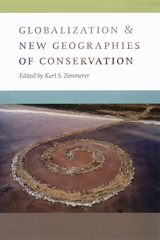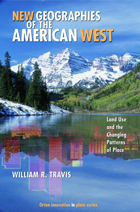3 books about New Geographies

Globalization and New Geographies of Conservation
Edited by Karl S. Zimmerer
University of Chicago Press, 2006
Examining the geographical dimensions of environmental management and conservation activities implemented on landscapes worldwide, Globalization and New Geographies of Conservation creates a new framework and collects original case studies to explore recent developments in the interaction of humans and their environment.
Globalization and New Geographies of Conservation makes four important arguments about the recent coupling of conservation and globalization that is reshaping the place of nature in human-environmental change. First, it has led to an unprecedented number of spatial arrangements whose environmental management goals and prescribed activities vary along a spectrum from strict biodiversity protection to sustainable utilization involving agriculture, food production, and extractive activities. Conservation and globalization are also leading, by necessity, to new scales of management in these activities that rely on environmental science, thus shifting the spatial patterning of humans and the environment. This interaction results, as well, in the unprecedented importance of boundaries and borders; transnational border issues pose both opportunities and threats to global conservation proposed by organizations and institutions that are themselves international. Lastly, Globalization and New Geographies of Conservation argues that the local level has been integral to globalization, while the regional level is often eclipsed at the peril of the successful implementation of conservation and management programs.
Bridging the gap between geography and life science, Globalization and New Geographies of Conservation will appeal to a broad range of students of the environment, conservation planning; biodiversity management, and development and globalization studies.
Globalization and New Geographies of Conservation makes four important arguments about the recent coupling of conservation and globalization that is reshaping the place of nature in human-environmental change. First, it has led to an unprecedented number of spatial arrangements whose environmental management goals and prescribed activities vary along a spectrum from strict biodiversity protection to sustainable utilization involving agriculture, food production, and extractive activities. Conservation and globalization are also leading, by necessity, to new scales of management in these activities that rely on environmental science, thus shifting the spatial patterning of humans and the environment. This interaction results, as well, in the unprecedented importance of boundaries and borders; transnational border issues pose both opportunities and threats to global conservation proposed by organizations and institutions that are themselves international. Lastly, Globalization and New Geographies of Conservation argues that the local level has been integral to globalization, while the regional level is often eclipsed at the peril of the successful implementation of conservation and management programs.
Bridging the gap between geography and life science, Globalization and New Geographies of Conservation will appeal to a broad range of students of the environment, conservation planning; biodiversity management, and development and globalization studies.
[more]

New Geographies, 12
Commons
Mojdeh Mahdavi and Liang Wang
Harvard University Press
This issue of New Geographies aims to foreground the significance of political thinking in the process of space production. It proposes the concept of commons as a mode of thinking that challenges assumptions in the design disciplines such as public and private spaces, local and regional geographies, and capital and state interventions.
[more]

New Geographies of the American West
Land Use and the Changing Patterns of Place
William R. Travis
Island Press, 2006
Reconciling explosive growth with often majestic landscape defines New Geographies of the American West. Geographer William Travis examines contemporary land use changes and development patterns from the Mississippi to the Pacific, and assesses the ecological and social outcomes of Western development.
Unlike previous "boom" periods dependent on oil or gold, the modern population explosion in the West reflects a sustained passion for living in this specific landscape. But the encroaching exurbs, ranchettes, and ski resorts are slicing away at the very environment that Westerners cherish.
Efforts to manage growth in the West are usually stymied at the state and local levels. Is it possible to improve development patterns within the West's traditional anti-planning, pro-growth milieu, or is a new model needed? Can the region develop sustainably, protecting and managing its defining wildness, while benefiting from it, too? Travis takes up the challenge , suggesting that functional and attractive settlement can be embedded in preserved lands, working landscapes, and healthy ecologies.
[more]
READERS
Browse our collection.
PUBLISHERS
See BiblioVault's publisher services.
STUDENT SERVICES
Files for college accessibility offices.
UChicago Accessibility Resources
home | accessibility | search | about | contact us
BiblioVault ® 2001 - 2024
The University of Chicago Press









